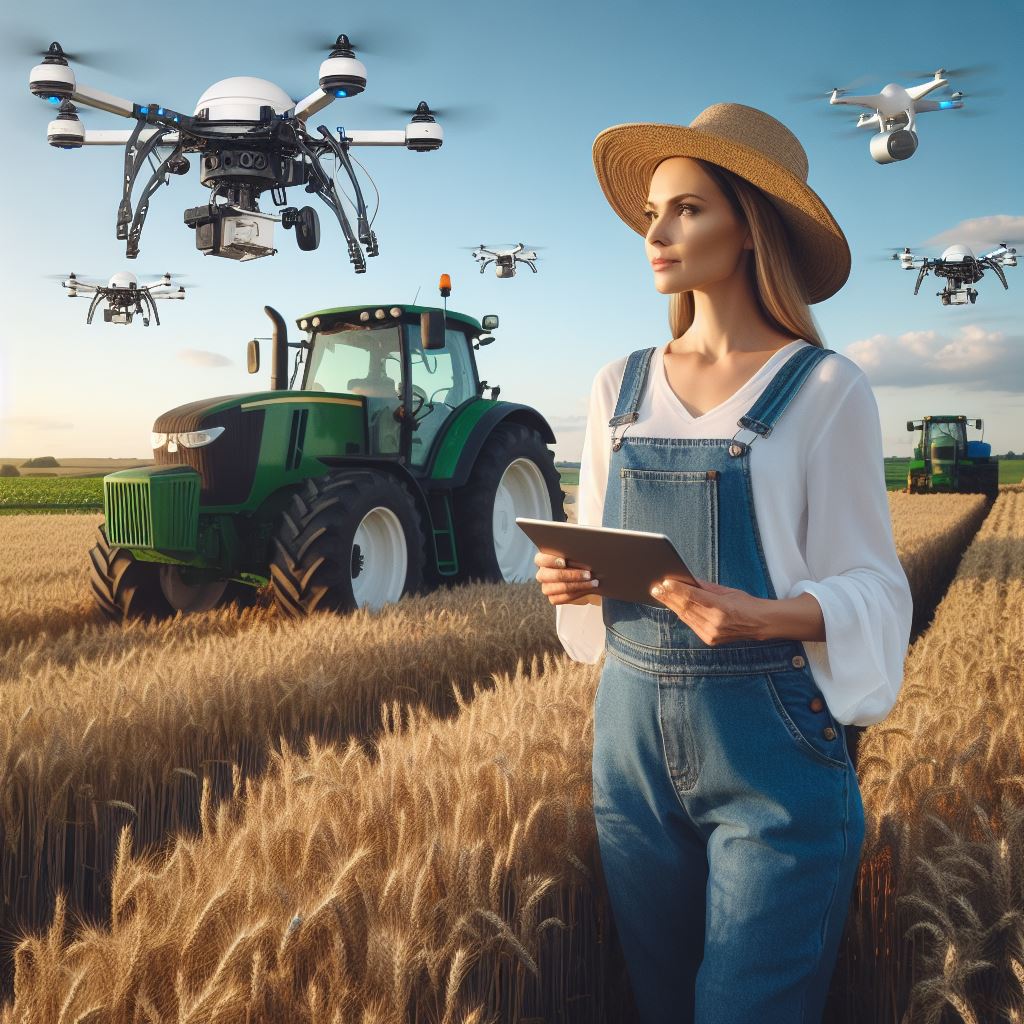Introduction
Newcomer City to Farm Story.
Moving from the bustling city to embracing a farming lifestyle has become a growing trend.
The transition can be inspiring and guide others in pursuing their dreams.
Sharing stories and experiences is crucial to this journey.
In recent years, there has been an intriguing shift in people’s lifestyles.
More and more individuals are deciding to leave behind the chaos and noise of the city to embark on a rural adventure.
The allure of the farm life, with its simplicity and connection to nature, has captured their hearts.
This increasing trend is a delightful surprise, as it signifies a renewed appreciation for nature and a desire for a more sustainable lifestyle.
People are realizing the deep fulfillment that can come from nurturing the earth and reaping the rewards of their own hard work.
There is a sense of purpose that feels lost in the concrete jungle.
The beauty of this movement is the opportunity to share our stories and experiences.
By recounting our own journey, we can inspire and guide others who are contemplating a similar leap of faith.
Whether it’s the challenges we faced or the triumphs we celebrated, our stories hold invaluable wisdom.
Through shared experiences, we can offer practical advice, shedding light on what to expect when transitioning from city life to the farm.
We can provide reassurance to those who may be feeling overwhelmed and unsure about their decision.
Our stories serve as beacons of hope, reminding others that they are not alone on this path.
In general, the transition from city to farm is an exciting and life-changing experience.
As newcomers to this lifestyle, we have the power to inspire and guide others through the sharing of our stories.
Let us embrace this opportunity to connect, encourage, and uplift one another on this remarkable journey.
Background
The author, let’s call her Sarah, grew up in a bustling city, surrounded by skyscrapers and concrete jungles.
She lived a fast-paced life and was successful in her career.
However, as the years went by, Sarah started feeling disconnected from nature and longed for a simpler, more fulfilling existence.
After a lot of contemplation, Sarah made the daring decision to leave the city behind and embark on a farming journey.
She was drawn to the idea of working with her hands, being self-sufficient, and living in harmony with the earth.
The desire to reconnect with nature and lead a more sustainable lifestyle fueled her motivations.
Motivations and Aspirations
Sarah’s intentions were clear.
She wanted to grow her own food, contribute to the local community, and reduce her carbon footprint.
She dreamt of living off the land, sowing seeds, nurturing plants, and seeing them flourish into bountiful harvests.
By choosing farming, she hoped to make a positive impact on the environment and promote sustainable practices.
Furthermore, Sarah aspired to create a haven where people could escape the noise and fast-paced lifestyles of the city.
She envisioned a place where individuals could reconnect with nature, learn about sustainable farming, and find solace in the simplicity of life.
This dream ignited a fire within Sarah, pushing her to overcome any challenges that lay in her path.
Relevant Experiences and Challenges
As a city dweller, transitioning to farm life was not without its hardships.
Sarah had to learn everything from scratch – from understanding the soil composition to mastering the art of organic farming.
She faced countless challenges, from dealing with unpredictable weather conditions to battling pests that threatened her crops.
The solitude of farm life also posed a steep learning curve.
Sarah missed the social interactions she had in the city and felt isolated at times.
However, she found solace in the beauty of nature surrounding her, which became her constant companion.
Another crucial challenge Sarah encountered was marketing her farm produce.
She had to establish connections with local markets and develop strategies to attract customers.
Through trial and error, she learned the art of selling her organic produce and connecting with like-minded individuals in her community.
Despite the obstacles, Sarah’s perseverance paid off.
Her farm flourished, and she found a thriving community of individuals who shared her passion for sustainable living.
Connecting with other farmers, attending workshops, and constantly learning from her experiences fueled Sarah’s growth.
Transform Your Agribusiness
Unlock your farm's potential with expert advice tailored to your needs. Get actionable steps that drive real results.
Get StartedIn summary, Sarah’s journey from the city to the farm was not an easy one, but it was immensely rewarding.
Her motivations to reconnect with nature, live sustainably, and create a haven for others drove her every step of the way.
Through hard work and determination, she overcame challenges and fulfilled her aspirations, finding joy and fulfillment in her new farming lifestyle.
Choosing the Farm
The process of selecting a suitable farm
When it comes to selecting a suitable farm, there are several factors that need to be considered.
It’s not a decision to be taken lightly, as it will impact your life and the success of your farming venture.
Firstly, size plays a crucial role.
The size of the farm should align with your goals and the type of farming you wish to pursue.
Too large of a farm may be overwhelming for newcomers, while a small farm might limit your potential for growth.
factors considered such as size, location, and resources available
Next, location is key.
Accessibility to markets, suppliers, and community support can greatly affect your farm’s profitability and sustainability.
Choosing a farm that is close to your target market can reduce transportation costs and increase sales opportunities.
Furthermore, the resources available on the farm are vital.
Assess the land’s fertility, availability of water sources, and the presence of necessary infrastructure like barns, sheds, or fencing.
Investing in improvements can be costly and time-consuming, so it’s essential to understand what you’re working with from the start.
The importance of understanding the specific needs and goals of the farming venture
Additionally, understanding the specific needs and goals of your farming venture is essential.
Are you planning to raise livestock, grow crops, or both?
Researching and analyzing the demands of your chosen farming activities will help you find the right farm suited to your aspirations.
Consider the available resources on the farm, such as machinery and equipment.
Will you need additional tools or can you work with what’s already there?
These details can affect your budget and overall productivity on the farm.
Moreover, it’s crucial to consider the financial aspect of purchasing a farm.
Evaluate your budget and determine if you have sufficient funds for an outright purchase or if you need to explore financing options.
Don’t forget to account for ongoing operational costs, such as maintenance, utilities, and labor.
Finally, seek advice from experienced farmers and professionals in the agricultural industry.
They can provide insights and guidance based on their own experiences, helping you navigate through this decision-making process.
In a nutshell, selecting a suitable farm involves careful consideration of various factors.
Size, location, and available resources are key elements to assess.
Understanding your specific needs and goals will guide you in finding the perfect farming venture.
Consultation with industry experts will provide valuable advice for making the right choice.+
Learning the Basics
Transitioning from city life to farm life was a steep learning curve for me.
I had to acquire basic farming knowledge and skills from scratch, facing several challenges in the process.
Understanding the Fundamentals
The first and most important step in my journey was to understand the fundamental concepts of farming.
I had to learn about different soil types, crop rotations, and pest control methods.
I turned to various resources to gain this knowledge.
Books on agriculture and sustainable farming practices became my constant companions.
I would spend hours poring over their pages, absorbing as much information as I could.
Additionally, I relied heavily on online tutorials that provided step-by-step instructions on farming techniques.
Videos demonstrating practical aspects of farming proved to be incredibly helpful in visualizing the processes.
Hands-On Experience
Acquiring theoretical knowledge was just the first step.
I soon realized that practical experience was crucial to truly grasp the farming process.
Through trial and error, I learned how to prepare the soil, sow seeds, and tend to growing crops.
It was challenging at first, but with time, I became familiar with the intricacies of farm work.
One of the major challenges I faced was dealing with pests and diseases that attacked my crops.
I had to quickly learn how to identify and eliminate these threats, using organic and sustainable methods to protect my plants.
My mentor, an experienced farmer in the community, played a significant role in helping me navigate these challenges.
Their guidance and expertise gave me confidence and taught me valuable lessons that couldn’t be found in books or online tutorials.
Joining Mentorship Programs
Recognizing the importance of mentorship, I actively sought out local programs that paired newcomers like me with experienced farmers.
Being a part of a mentorship program provided me with invaluable support and guidance.
I had the opportunity to learn directly from seasoned farmers who shared their wisdom and expertise with me.
Working alongside my mentor allowed me to gain hands-on experience, and they were always there to answer my questions and address any concerns.
It was a reassuring feeling to have someone by my side when faced with unfamiliar challenges.
Embracing Challenges
Transitioning from city life to farm life was undoubtedly a significant change.
However, through perseverance and a willingness to learn, I gradually overcame the challenges that came my way.
The learning curve was steep, but each obstacle I encountered allowed me to grow and become more adept at farming.
It was a fulfilling journey, filled with lessons about resilience and adaptability.
While I continue to learn new things every day, I can confidently say that I have acquired the basic farming knowledge and skills necessary to thrive in my newfound lifestyle.
Showcase Your Farming Business
Publish your professional farming services profile on our blog for a one-time fee of $200 and reach a dedicated audience of farmers and agribusiness owners.
Publish Your ProfileTransitioning from the city to the farm was not easy, but it was undoubtedly a decision that changed my life for the better.
Embracing the challenges and learning the basics of farming has allowed me to find fulfillment in a simpler, more sustainable way of life.
Read: She Grows: The Rise of Female Farm Entrepreneurs
Building Infrastructure
Setting up necessary infrastructure on the farm involves a detailed and systematic process.
Here, we will delve into the tasks required, challenges faced, and rewards gained in creating a functional and efficient farming environment.
Establishing Fences
The first step in building infrastructure is to ensure boundaries are properly marked with sturdy fences.
These fences not only keep livestock secure but also protect crops from potential damage caused by grazing animals.
Constructing Barns
Barns serve as multipurpose structures on a farm, providing shelter for livestock, storage for equipment, and a workspace for various farming activities.
Constructing sturdy and well-designed barns is essential for smooth operations.
Installing a Water Supply System
A reliable and efficient water supply is crucial for maintaining a healthy farm environment.
Installing pipelines, water storage tanks, and troughs ensures that both livestock and crops have access to clean water, contributing to their overall well-being.
The Challenges
Building necessary infrastructure on a farm comes with its fair share of challenges.
One of the main difficulties is the initial cost of materials and construction.
Fencing materials, barn construction, and water supply systems can be quite expensive.
Another challenge lies in the labor involved.
Setting up fences, constructing barns, and installing water supply systems require skilled workers who are familiar with the intricacies of each task.
Furthermore, adapting to the local climate and terrain can pose challenges when building infrastructure.
Farms located in areas with extreme weather conditions, uneven grounds, or limited water resources may require additional planning and modifications.
The Rewards
Despite the challenges, there are numerous rewards in creating a functional and efficient farming environment through infrastructure development.
First and foremost, having well-defined boundaries through fences ensures that livestock remains secure within the farm.
This prevents incidents of animals straying or getting lost, ultimately safeguarding their well-being.
Well-constructed barns provide shelter and protection from harsh weather conditions, reducing the risks of health issues among livestock.
Additionally, barns offer convenient storage for equipment, making it easily accessible and protected from damage.
A reliable water supply system is essential for the survival and growth of both crops and livestock.
Access to clean water ensures optimal health, leading to better productivity and higher quality produce or livestock.
Lastly, a functional and efficient farming environment leads to increased productivity and profitability.
When infrastructure is well-established, farmers can focus on various farming activities without worrying about the stability or safety of their farming environment.
In closing, building necessary infrastructure on a farm is a crucial process that involves tasks such as establishing fences, constructing barns, and installing a water supply system.
While it may present challenges, the rewards include the security of livestock, protection from harsh weather conditions, access to clean water, and improved productivity.
Infrastructure development sets the foundation for a successful farming venture.
Read: New Age Farmers: Young Women in Agriculture

Cultivating the Land
The Importance of Soil Preparation and Crop Planning
- Proper soil preparation is crucial for successful farming as it creates a favorable environment for plants to thrive.
- Testing the soil’s pH level and nutrient content helps determine the right amendments to improve its quality.
- Adequate drainage and irrigation systems ensure water reaches the plants’ root zone without waterlogging the soil.
- Crop planning involves selecting the right crops for the soil type, climate, and market demand to maximize yield and profit.
- Rotation of crops helps prevent pest and disease buildup while improving soil fertility and reducing soil erosion.
Experiences and Lessons Learned While Tending to the Land for the First Time
- As a newcomer to farming, every day brought a new learning experience filled with both joys and challenges.
- Initially, understanding the land’s needs and adapting to a farming routine required patience and perseverance.
- Learning from experienced farmers and seeking guidance from agricultural experts proved invaluable.
- Trial and error was a significant part of the learning process, as some crops thrived while others struggled.
- Being attentive to nature’s cues and adapting farming practices accordingly was essential for success.
Strategies for Organic Farming or Sustainable Agriculture
- Embracing organic farming practices, such as avoiding synthetic pesticides and fertilizers, promotes environmental sustainability.
- Implementing crop rotation and cover cropping ensures healthier soil, reduced pests, and improved biodiversity.
- Composting organic waste and using it as natural fertilizer enriches the soil and minimizes reliance on chemical inputs.
- Integrated pest management techniques, like using beneficial insects and trap crops, help control pests without harmful chemicals.
- Conserving water through drip irrigation, rainwater harvesting, and efficient water management practices further supports sustainability.
Transitioning from city to farm life required understanding the significance of soil preparation, crop planning, and sustainable practices.
By cultivating the land responsibly and learning from experiences, newcomers can embrace organic farming and contribute to a sustainable agricultural future.
Read: Microgreens Business: A Farmer’s Perspective
Raising Livestock
When I made the decision to leave the city behind and start a farm, incorporating livestock was a key element of my plan.
Challenges
- One of the biggest challenges in raising animals was learning how to properly care for them.
- There was a learning curve involved in understanding their different needs and behaviors.
- I had to invest time and effort in building appropriate shelters and ensuring a secure environment.
- Dealing with potential health issues and finding reliable veterinarians was also a challenge.
Rewards
Despite the challenges, the rewards of raising livestock have been immense.
- First and foremost, it brings me joy and fulfillment to be surrounded by these animals every day.
- The connection I have developed with them is incredibly rewarding.
- Additionally, livestock has provided me with a source of income through selling their products.
- I have also noticed how my animals contribute to the overall health and sustainability of the farm.
Responsibilities
Along with the rewards come great responsibilities.
Raising animals requires a significant amount of time and effort.
- I have to ensure that their basic needs such as food, water, and shelter are always met.
- Regular monitoring of their health and well-being is crucial for their overall happiness and productivity.
- Cleaning and maintaining their living spaces is an ongoing task that demands attention to detail.
- Responsibly managing their breeding and reproduction processes contributes to the success of the farm.
Experiences and Anecdotes
Throughout my journey with livestock management, I have had numerous memorable experiences and anecdotes.
- One funny incident involved a curious goat named Charlie who managed to escape from its pen multiple times.
- Another heartwarming story is about a rescued cow named Daisy who has become like a member of our family.
- Witnessing the birth of a calf for the first time was both exhilarating and nerve-wracking.
- The bond that has formed between my children and our animals has been truly special to witness.
Reflecting on my decision to incorporate livestock into my farming operation, I can confidently say that it was the right choice.
Though it has come with its fair share of challenges and responsibilities, the rewards and experiences have been invaluable.
From connecting with these animals on a deeper level to seeing the impact they have on the farm’s sustainability, raising livestock has enhanced my farming journey in countless ways.
Read: Farm Wisdom: Insights from Veteran Female Farmers
Navigating Market Opportunities
When I made the decision to leave city life behind and start a farm in a rural area, I knew that finding and connecting with local markets would be essential for the success of my business.
Here are the experiences I had and the strategies I utilized for marketing farm products and finding customers.
Finding and Connecting with Local Markets
- Attending local farmers markets was my first step in connecting with the community.
- I introduced myself to fellow farmers and developed relationships with them, learning from their experiences.
- By understanding the preferences of the local consumer, I was able to tailor my products accordingly.
- Visiting local grocery stores and restaurants allowed me to identify potential partnership opportunities.
- Regularly participating in community events and fairs helped me showcase my products and network with potential customers.
Strategies for Marketing Farm Products and Finding Customers
- I utilized social media platforms to create an online presence and share information about my farm and products.
- Building a website helped me showcase my products, share their benefits, and provide contact information.
- Implementing email marketing campaigns allowed me to stay in touch with customers and offer special promotions.
- Offering farm tours and workshops provided an immersive experience for customers and helped build brand loyalty.
- Collaborating with local restaurants and cafes to feature my products on their menus increased visibility.
Challenges Faced and Lessons Learned
- Initially, it was challenging to understand the specific demands of the local market and cater to them effectively.
- Building a customer base from scratch required patience, consistent effort, and a strong marketing strategy.
- Pricing farm products competitively while considering production costs and maintaining profitability was a constant challenge.
- Dealing with unpredictable weather conditions and their impact on crop yields required flexibility and resilience.
- I learned the importance of constantly evaluating and adapting marketing strategies based on feedback and market trends.
In fact, navigating market opportunities as a newcomer to the farming industry can be both challenging and rewarding.
By actively connecting with local markets, utilizing effective marketing strategies, and learning from challenges, I was able to establish a customer base and grow my farm business successfully.
Reflection and Future Outlook
Transitioning from bustling city life to serene farm living brought profound changes.
Embracing nature’s rhythm, I found fulfillment and purpose in the simple joys of farming.
Every day brought new challenges, but also opportunities for personal growth and learning.
From planting seeds to harvesting crops, each task fostered a deeper connection to the land.
The satisfaction of nurturing life and witnessing the fruits of my labor was unparalleled.
Amidst the peaceful countryside, I rediscovered a sense of balance and harmony in life.
The slower pace allowed for reflection, introspection, and appreciation of life’s natural beauty.
Despite initial doubts and uncertainties, the farming journey has been immensely rewarding.
Looking ahead, my aspirations for the farm are filled with excitement and optimism.
I envision expanding our sustainable practices, embracing innovation, and fostering community engagement.
Building upon our successes, I aim to diversify crops, increase yields, and improve farm efficiency.
Moreover, I hope to share our experiences and knowledge with others, inspiring a deeper connection to food and farming.
Showcase Your Farming Business
Publish your professional farming services profile on our blog for a one-time fee of $200 and reach a dedicated audience of farmers and agribusiness owners.
Publish Your ProfileIn the coming years, I plan to explore agro-tourism opportunities, inviting visitors to experience farm life firsthand.
Through education and outreach, I aspire to promote environmental stewardship and sustainable living practices.
While challenges may arise, I am confident in our ability to adapt, grow, and thrive as stewards of the land.
In short, transitioning from city to farm life has been a transformative journey filled with growth and fulfillment.
As I look towards the future, I am excited to continue this adventure, embracing new opportunities and realizing our farm’s full potential.
Conclusion
The journey from the city to the farm has been transformative for our protagonist.
They have shared their challenges, triumphs, and lessons learned throughout this blog post.
The key points discussed include the initial struggles, the sense of community, and the growth as a farmer.
It is important to recognize and appreciate the support and guidance provided by the farming community.
By sharing their stories and experiences, readers can contribute to the collective wisdom and understanding of the farming lifestyle.
We encourage readers to share their own stories and experiences in the comments section.
This will not only create a sense of solidarity but also enable others to learn from different perspectives.
Lastly, we reiterate the importance of supporting and learning from each other in the farming community.
The journey from the city to the farm can be challenging, but with a strong support system, everyone can thrive.
Let us continue to foster a supportive and inclusive community for farmers and newcomers alike.




